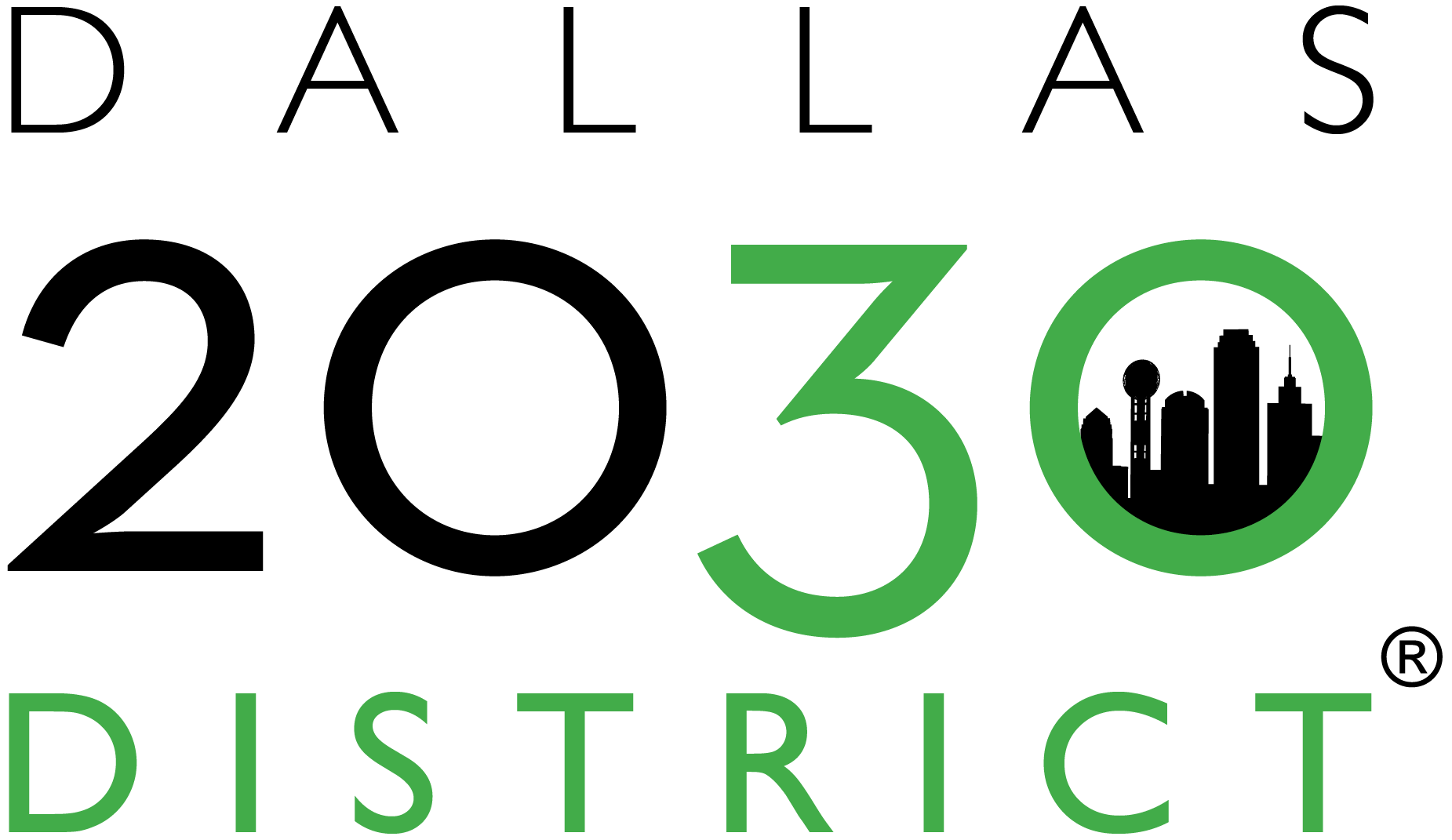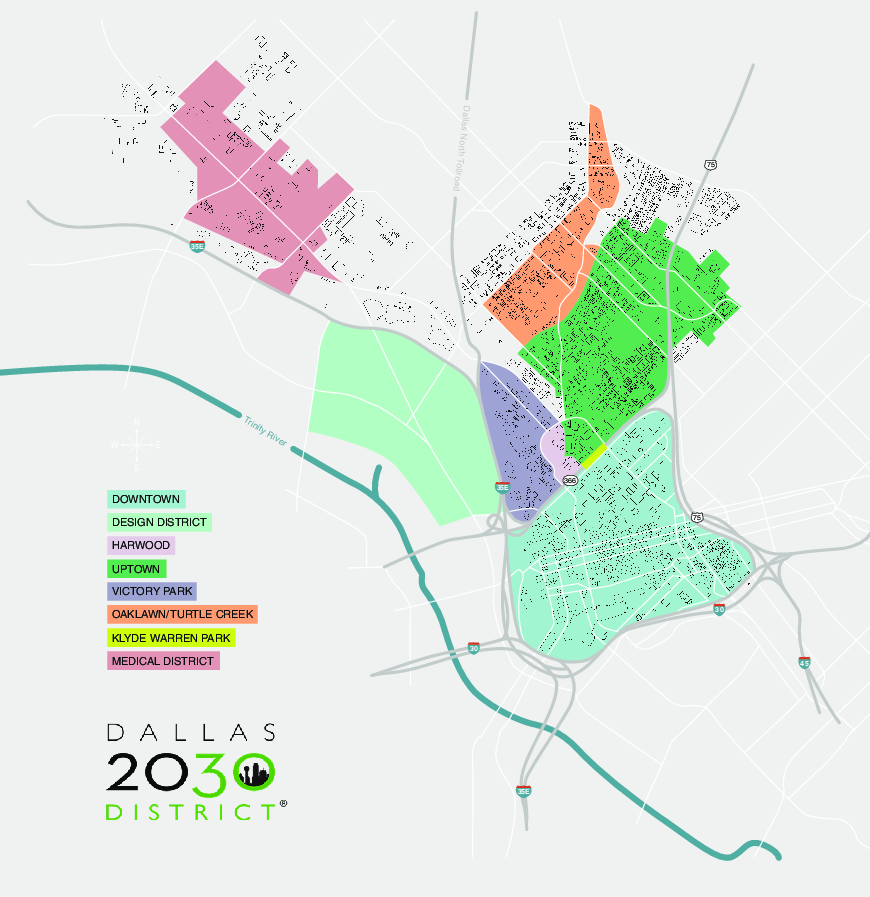Dallas 2030 FAQ
Who is involved?
The Dallas 2030 District is made up of members that are separated into three different stakeholder groups- Property Owners and Managers, Professional Members and Community Members. See the Members page for the current list of members.
Who can be a Member?
There are three categories of Members.
-Property Owners and Managers: Defined as individuals or entities that owns, manages and/or develops real estate within a 2030 District boundary.
-Professional Members: An individual or entity that provides services within a 2030 District boundary. Examples include architects, engineers, energy services companies (ESCOs), utilities, and contractors.
-Community Members: A not for profit entity, government entity, or a community organization. Examples of a Community Stakeholder include industry and/or professional organizations, local green building councils, city, county and state agencies, and community groups.
What does membership offer that I could not otherwise find on my own?
Membership in the Dallas 2030 District provides you an opportunity to build relationships with a unique community of innovators in the building community and leading organizations committed to making Dallas a environmentally sustainable and resilient city by 2030. The District also provides unique member services such as free educational and training programs, and other pro-bono or discounted professional services and products. Additional benefits include free access to Dallas 2030 District events, meetings, and the opportunity to connect with peers that are committed to sharing lessons-learned and realizing a high performing district.
What does it cost to be a member?
There are currently no fees associated with membership for Property Owners/Managers and Community Members; however, Professional Members are required to pay annual membership dues to participate in the District. Currently the annual dues required are $750/year for individuals or small organizations with less than 10 employees; and $1500/year for organizations with 10 or more employees. The membership dues contribute towards ensuring a sustainable funding model for the District and the funds are used to pay District staff salaries, provide technical trainings, conduct outreach and marketing campaigns and to hold District events and meetings.
What contributions are required from property owners, managers and developer members?
All property owners are required to share energy, water and transportation data with the District. Sharing of energy and water data is through the Portfolio Manager online tool. The data is kept anonymously and is not shared with other District members or third parties.
If we anonymously share water, energy and transportation information, how do we know this is secure? Who sees this data?
Published data will be aggregated at the District level for all reporting and tracking purposes. The reported data will be anonymous and will not identify individual buildings by owner, name, address, square footage or any other identifier. Data stays confidential.
How did you set the Performance Baselines?
Our energy reduction baseline is set by Energy Star, which is based on a national database. In accordance with the Architecture 2030 Challenge, the energy performance baseline will be the national average energy consumption of existing U.S. commercial buildings as reported by the 2003 Commercial Building Energy Consumption Survey (CBECS). CBECS data is a set of whole-building energy use measurements gathered by the DOE’s Energy Information Administration, which can be used to determine a national energy use intensity using kBtu/sq. ft.-yr as the metric. Water and transportation baselines are yet to be set but are based on actual consumption within the Dallas 2030 District boundary.
If I join as a Developer, does this require our organization to meet the District’s performance requirements for all our future renovation projects and/or new construction projects?
Property owners, managers and developers are required to make a good-faith effort to meet the District’s performance goals for the existing and/or new buildings under their control and in their portfolio within the 2030 District boundary. The timing for portfolio performance upgrades and/or the development of new properties is affected by a myriad of factors. There is not a requirement to bring individual existing buildings into compliance within a specific timeframe.
What’s the relationship between the Dallas 2030 District as a public-private partnership and the City of Dallas?
The Dallas 2030 District is a privately led, voluntary membership organization and participation is not required by any government entity. The City of Dallas supports the organization’s energy, water and transportation goals and has joined the District as a Community Members, as well as a Property Owner and Manager members.
How is the Dallas 2030 District related to or different from Architecture 2030, the AIA+2030 Professional Education Series, the AIA 2030 Commitment and other 2030 Districts around the United States?
The year 2030 is widely considered as the decisive deadline for achieving a carbon-free society in order to mitigate catastrophic climate change. In response to this crisis, the non-profit organization, Architecture 2030, was founded by Edward Mazria in 2002. This organization put forth the 2030 Challenge, a set of defined performance targets that incrementally step down carbon emissions from the built environment to zero emissions in the year 2030. To support this challenge, other organizations, such as the American Institute of Architects (AIA) have used these targets as the framework for programs such as the AIA’s 2030 Commitment. The AIA+2030 Professional Education Series is an education program created in partnership with Architecture 2030, and now provided by 23 AIA chapters and other partners throughout North America. 2030 Districts across the United States may vary in approach, however, they all establish performance goals based on the 2030 Challenge for Planners.

